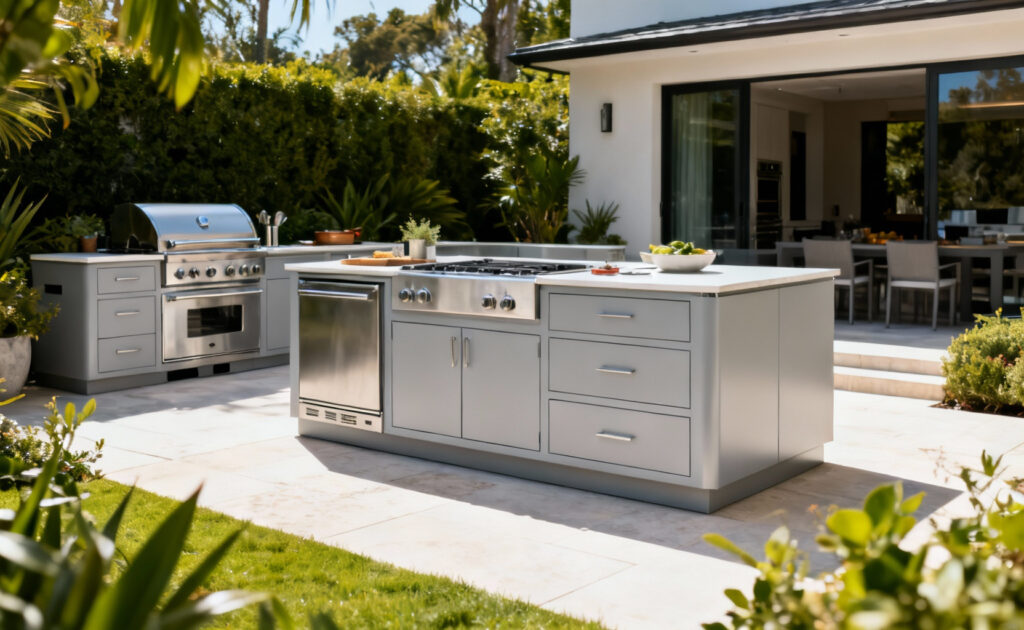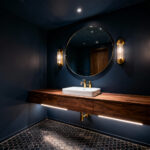Most folks believe choosing outdoor kitchen cabinets is pretty straightforward: pick a “weatherproof” material, make sure it looks good, and you’re done. You’ll hear this advice from general contractors and see it on countless home improvement shows. But they’re leaving out the most important part of the story. In my work as a landscape architect and outdoor living designer, I’ve seen firsthand how that simple advice leads to warped doors, rusted hardware, and disappointed homeowners within a few seasons. True longevity isn’t just about a single material; it’s about a complete system designed to work with nature, not against it.
What’s missing from the common narrative is the essential connection between material science, your specific regional climate, and a design that feels like it truly belongs to your home and landscape. This is where my professional experience has taught me the most valuable lessons. These 20 strategies are built on years of designing and observing outdoor spaces that thrive. We’re going to move beyond the surface-level talk and give you the insight to create an outdoor kitchen that endures beautifully.
We’ll start with the fundamentals that form the backbone of any solid outdoor kitchen. Then, we’ll move into more refined approaches that elevate both the function and style of your space. And finally, we’ll cover the professional-level strategies that create truly seamless, long-lasting outdoor rooms. This is your guide to getting it right, the first time.
Essential Outdoor Kitchen Cabinet Fundamentals (Part 1)
Building an outdoor kitchen that lasts starts with a deep respect for the elements. In this section, we’ll cover the foundational choices—from materials to climate considerations—that ensure your cabinets won’t just survive the weather, but will stand strong for years of gatherings and good food.
1. Prioritize Marine-Grade Polymer (HDPE) for Unrivaled Weather Resistance
When I talk about truly bombproof materials for outdoor kitchens, my first thought is almost always marine-grade polymer, also known as HDPE. It’s the perfect starting point because it directly solves the biggest challenge outdoors: moisture. Unlike wood, it will not rot. Unlike many metals, it cannot rust or corrode. It’s an incredibly forgiving and resilient foundation for any design, regardless of your climate.
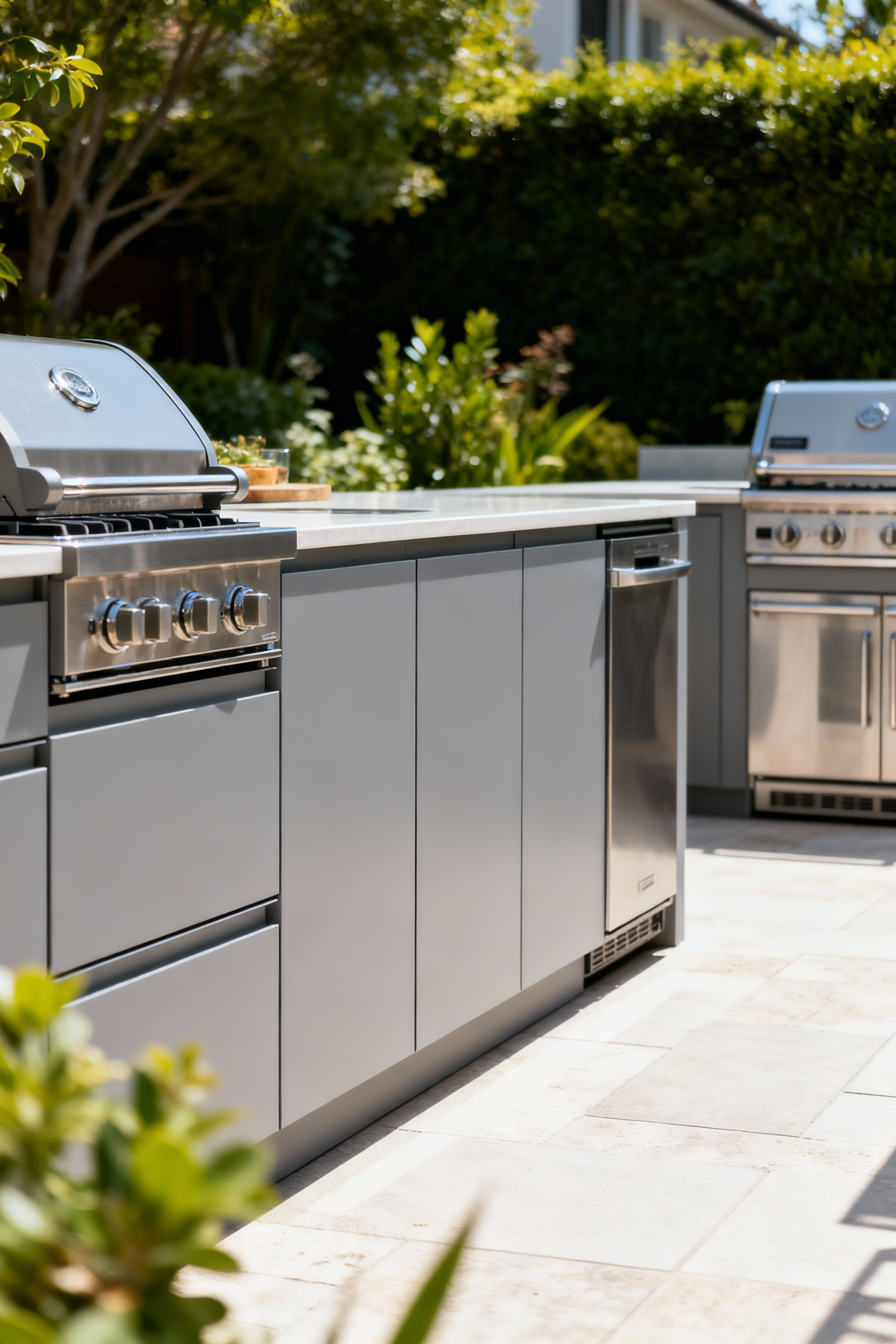
Now, let’s get a bit deeper. What “marine-grade” actually means is that this material is built to withstand constant assault from UV rays, salt spray, wild temperature swings, and even harsh cleaning chemicals. From my outdoor living design expert practice, I’ve specified HDPE for coastal projects where salt fog would eat through lesser materials in a year, and it looks just as good five years later. Its surface is non-porous, so water simply can’t get in, which means no swelling, no warping, and no place for mildew to grow. That low-maintenance reality is what turns a beautiful outdoor space into one you actually get to relax in.
2. Assess Your Local Climate’s Unique Demands on Cabinet Material Selection
A common mistake is thinking “outdoor-rated” is a one-size-fits-all label. It’s not. The most important question you can ask is: what challenges does my specific climate present? A cabinet that performs beautifully in the dry heat of Arizona could fail spectacularly in the humid, salt-laden air of Florida. Frankly, ignoring your local weather is setting your investment up for a short, unhappy life.

This is where you need to think like a landscape designer. In coastal areas, salt is your enemy, so 316-grade stainless steel or HDPE are non-negotiable. For regions with intense sun, you must prioritize materials with robust UV inhibitors built-in to prevent them from fading and becoming brittle. And if you live where freeze-thaw cycles are the norm, any material that absorbs even a tiny amount of water is a risk; that trapped moisture will freeze, expand, and tear the material apart from the inside.
Essential Outdoor Kitchen Cabinet Fundamentals (Part 2)
With a solid grasp of materials and climate, let’s build on that foundation. This section is about the critical differences that define true outdoor cabinetry and the art of placing it wisely. Getting these details right ensures your kitchen not only endures but feels perfectly integrated into your outdoor life.
3. Differentiate True Outdoor-Rated Cabinetry from Interior Substitutions for Longevity
It can be tempting to look at a less expensive indoor cabinet and think, “How different can it be?” The answer is, profoundly different. From my work in patio design, I’ve been called in to fix far too many outdoor kitchens where someone tried to cut this corner. Interior cabinets are built for a climate-controlled world. Their particleboard cores and standard adhesives act like sponges in humid air, leading to swelling, peeling finishes, and total structural failure.
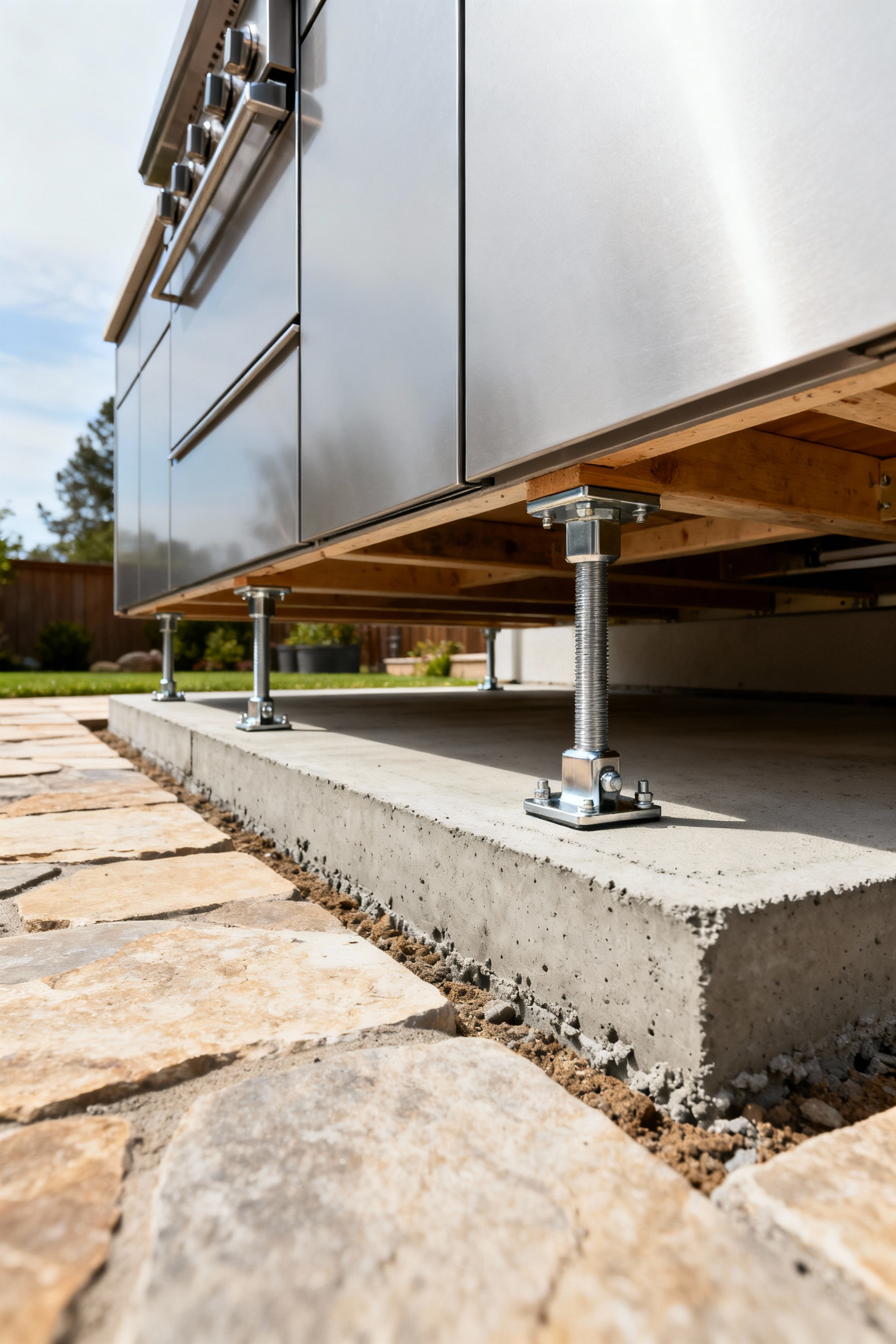
True outdoor kitchen cabinets are engineered from the ground up to fight moisture and UV rays. The core materials we’ve discussed—marine-grade polymer (HDPE), 304 or 316 stainless steel, and powder-coated aluminum—are just the beginning. The construction matters, too. Look for welded frames that offer superior strength, and hardware made from marine-grade stainless steel. An indoor cabinet is an assembly of parts; a great outdoor cabinet is a unified system built for defiance against the elements.
4. Master the Art of Strategic Placement for Optimal Elemental Protection and Usability
Once you’ve chosen the right materials, where you place them is your next best tool for ensuring their longevity. This is where my landscape architecture background really comes into play. The most straightforward strategy is providing cover. Placing your cabinets under a deep roof overhang, a solid pergola, or a covered porch immediately shields them from the worst of the sun and rain, drastically extending their life and good looks.
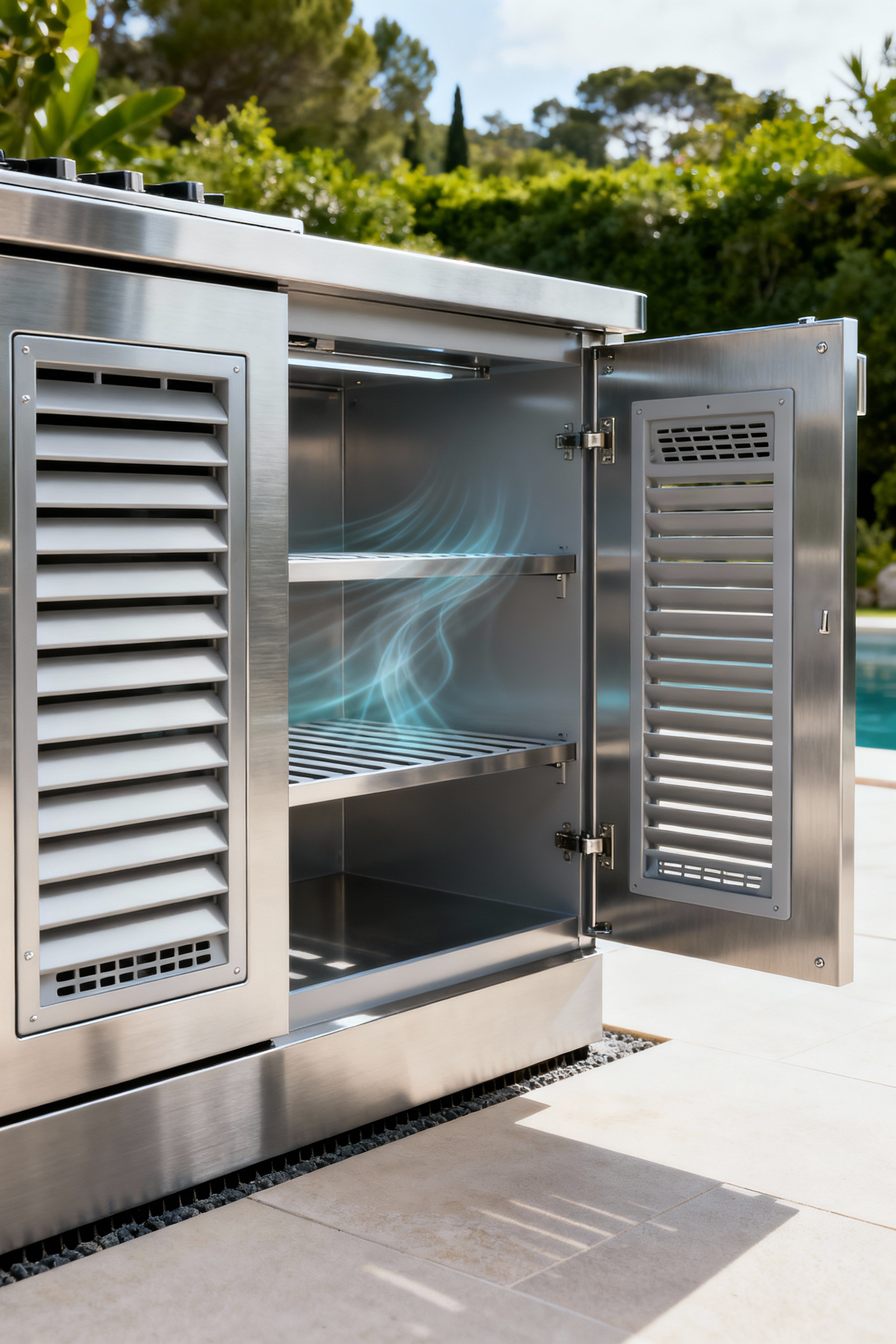
But strategic placement is also about creating a space that feels right and functions effortlessly. Think about your workflow—the “outdoor kitchen triangle” between the grill, sink, and refrigerator should feel natural. Consider the path of the sun throughout the day; you don’t want the afternoon glare directly in your eyes while you’re trying to prep food. And here’s what I always tell my clients: pay attention to the prevailing wind. Position your grill so smoke blows away from your dining table and guests, not toward them. Smart placement is the invisible ingredient that makes an outdoor kitchen a genuine pleasure to use.
Elevating Your Outdoor Kitchen Cabinet Approach (Part 1)
A good outdoor kitchen is functional. A great one is an experience. This section focuses on the design strategies that elevate your space from a simple cooking area to a sophisticated outdoor room—thinking about workflow, seamless appliance integration, and the small-but-critical details that signal true quality.
5. Design Optimal Layouts that Enhance Workflow Efficiency and Culinary Enjoyment
The best outdoor kitchens are designed around how you actually cook and entertain. It’s about creating a natural flow. You should be able to move from the fridge to the prep counter with a sink, and then to the grill without crossing back and forth or bumping into guests. This is the heart of an efficient layout—making the space work for you, not against you.

What really separates a professionally designed space is the attention to ergonomics within those zones. That means countertops at a comfortable working height and storage that makes sense—utensils and spices right next to the grill, trash and recycling hidden under the prep area. Years of patio design taught me that the goal is to create an outdoor culinary ecosystem where everything you need is exactly where you’d expect it to be, making the whole experience of cooking outside feel intuitive and relaxed.
6. Integrate Purpose-Built Enclosures for Specialty Appliances for Seamless Aesthetics
You can always spot an amateur outdoor kitchen by how the appliances are installed. Just cutting a hole in the countertop for a drop-in grill gets the job done, but it rarely looks finished. The goal is to make your appliances look like they truly belong. Purpose-built enclosures are the key to achieving that seamless, high-end, built-in appearance.

This means specifying outdoor kitchen cabinets designed with the exact dimensions, clearances, and—this part’s important—ventilation needs of your grill, side burners, or outdoor refrigerator. I learned this when a client’s beautifully designed kitchen had an improperly ventilated fridge that kept overheating. Good design anticipates these needs, discreetly managing gas lines and electrical wiring within the cabinetry. When done right, appliances don’t look like additions; they look like integral parts of a single, cohesive design.
7. Specify Advanced Marine-Grade Stainless Steel Fasteners and Hardware for Enhanced Resilience
This is one of those insider details that makes all the difference. What gets me is seeing a beautiful, expensive set of outdoor kitchen cabinets fail because the designer skimped on the screws and hinges. Basic stainless steel just won’t cut it in the long run, especially near the coast. It will eventually show signs of “tea staining” or, worse, outright rust.
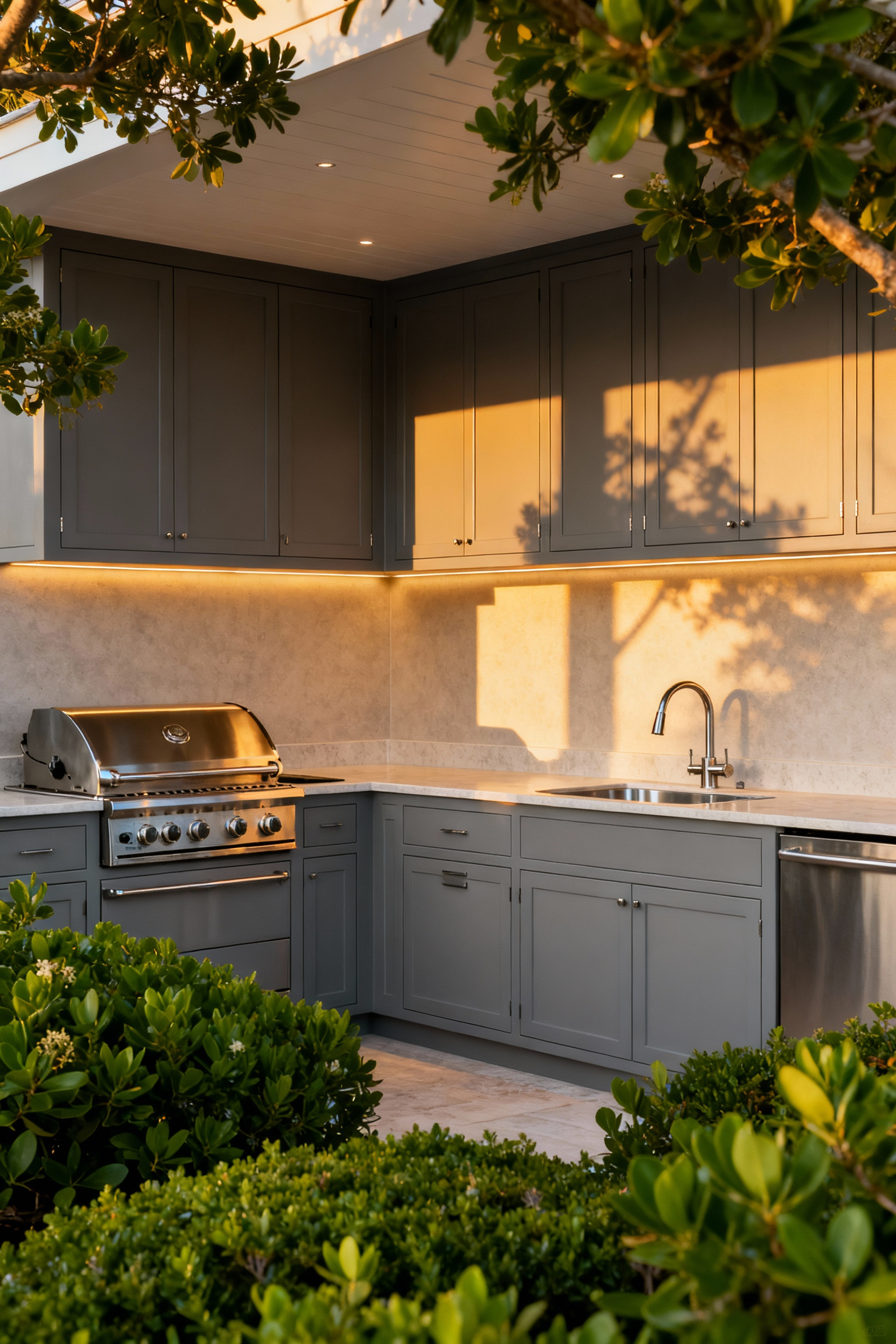
For any project I work on, specifying marine-grade 316L stainless steel for all fasteners, hinges, and drawer slides is non-negotiable. This specific alloy includes molybdenum, which gives it dramatically better protection against corrosion from salt and chemicals. It’s a small detail that most people will never see, but it’s precisely what ensures your doors will continue to close smoothly and your drawers will glide effortlessly, year after year. It’s the mark of a kitchen built for the long haul.
8. Explore Innovative UV-Stabilized and Scratch-Resistant Finish Coatings
The finish on your cabinets is their first line of defense. Sun is the primary enemy—it breaks down color and integrity over time, making surfaces look faded and chalky. So, moving beyond a standard exterior paint, you should look for advanced, multi-layer coating systems specifically engineered for outdoor cabinetry.
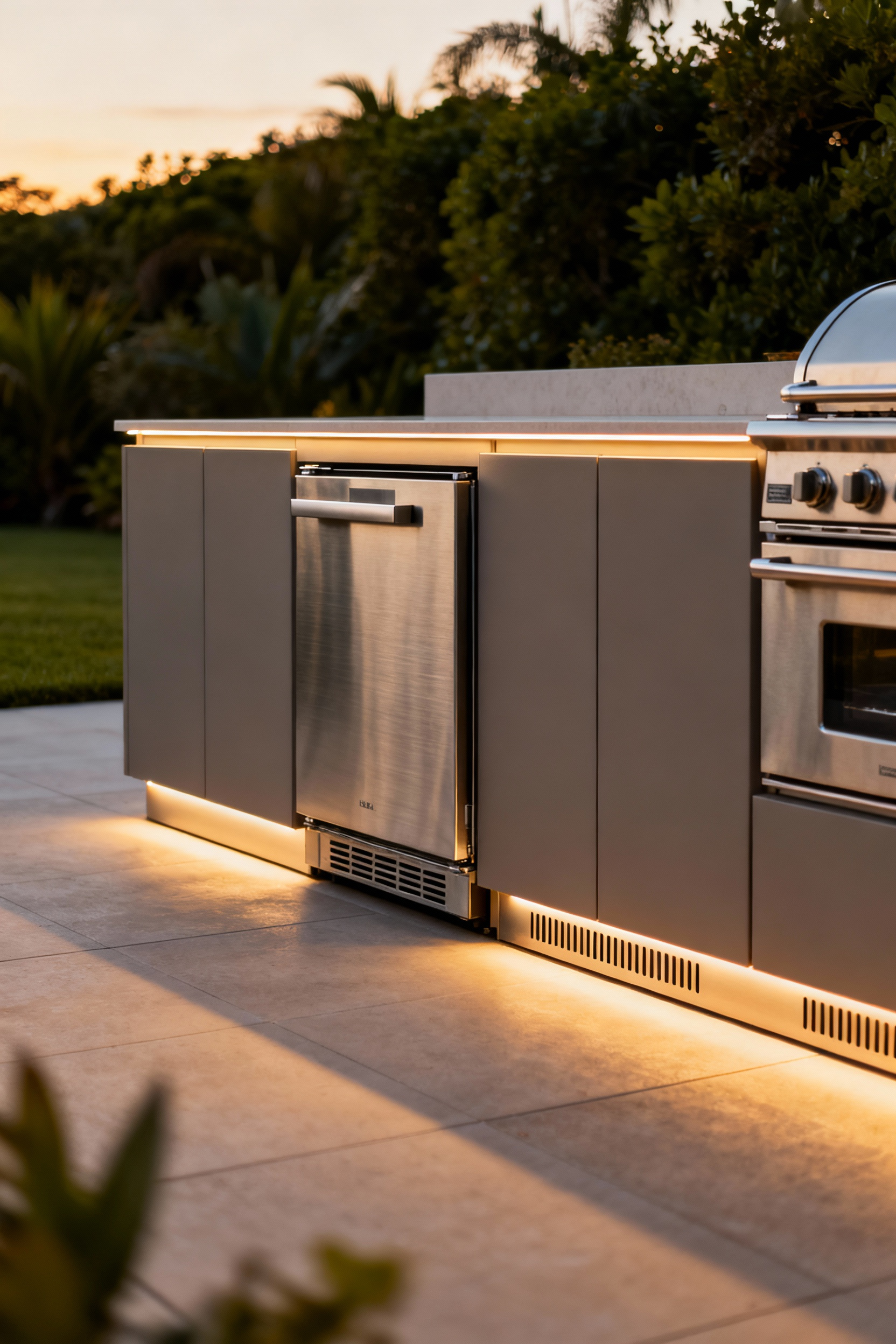
Think of it like the high-performance paint on a luxury car. A professional approach often involves a moisture-blocking primer, a durable color coat, and then a clear topcoat with powerful UV-stabilizers and even scratch-resistant properties. In my outdoor living design expert practice, I’ve found that investing in a superior factory finish up front saves clients countless hours and dollars in refinishing down the road. It ensures the beauty of the kitchen is as resilient as its structure.
Elevating Your Outdoor Kitchen Cabinet Approach (Part 2)
As we refine our approach, we focus on making the space smarter, not just stronger. This part is about maximizing every inch of storage, planning for the unseen utilities with professional precision, and building in the flexibility to adapt as your needs change over time.
9. Incorporate Intelligent Storage Systems and Organizational Accessories for Maximized Usability
A cluttered countertop can ruin the joy of cooking outdoors. True efficiency comes from intelligent storage inside your outdoor kitchen cabinets. Simply having empty boxes with a shelf inside is a missed opportunity. The goal is to have a designated, protected home for every tool, platter, and bottle of sauce.
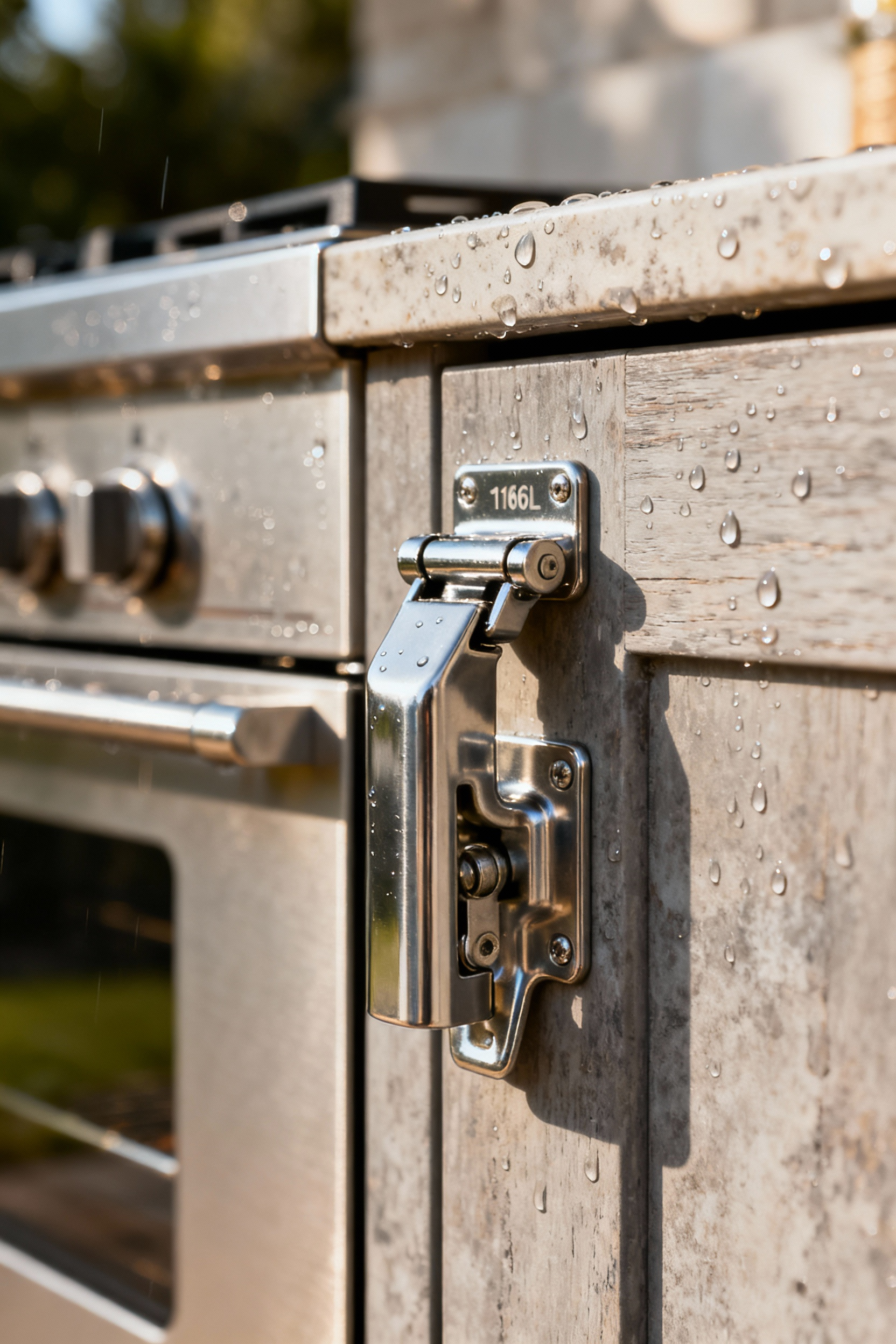
This means integrating thoughtful, weather-resistant solutions like pull-out trash and recycling bins, drawer dividers for utensils, and vertical storage for platters and cutting boards. I once designed a kitchen for a family that loves to entertain, and the father told me his favorite feature, hands down, was the double pull-out trash bin. It wasn’t the fancy grill; it was the simple, practical feature that kept the space clean and effortless during a party. These are the details that transform a good kitchen into one you love to use.
10. Plan for Dedicated, Code-Compliant Utilities Routing Within Cabinet Systems
This is the part of the project that is absolutely not glamorous, but it is one of the most critical. Properly and safely running your gas, water, and electrical lines is non-negotiable. Simply running exposed lines behind your cabinets is not only unsightly, it’s a hazard and an invitation for pests and weather-related damage.
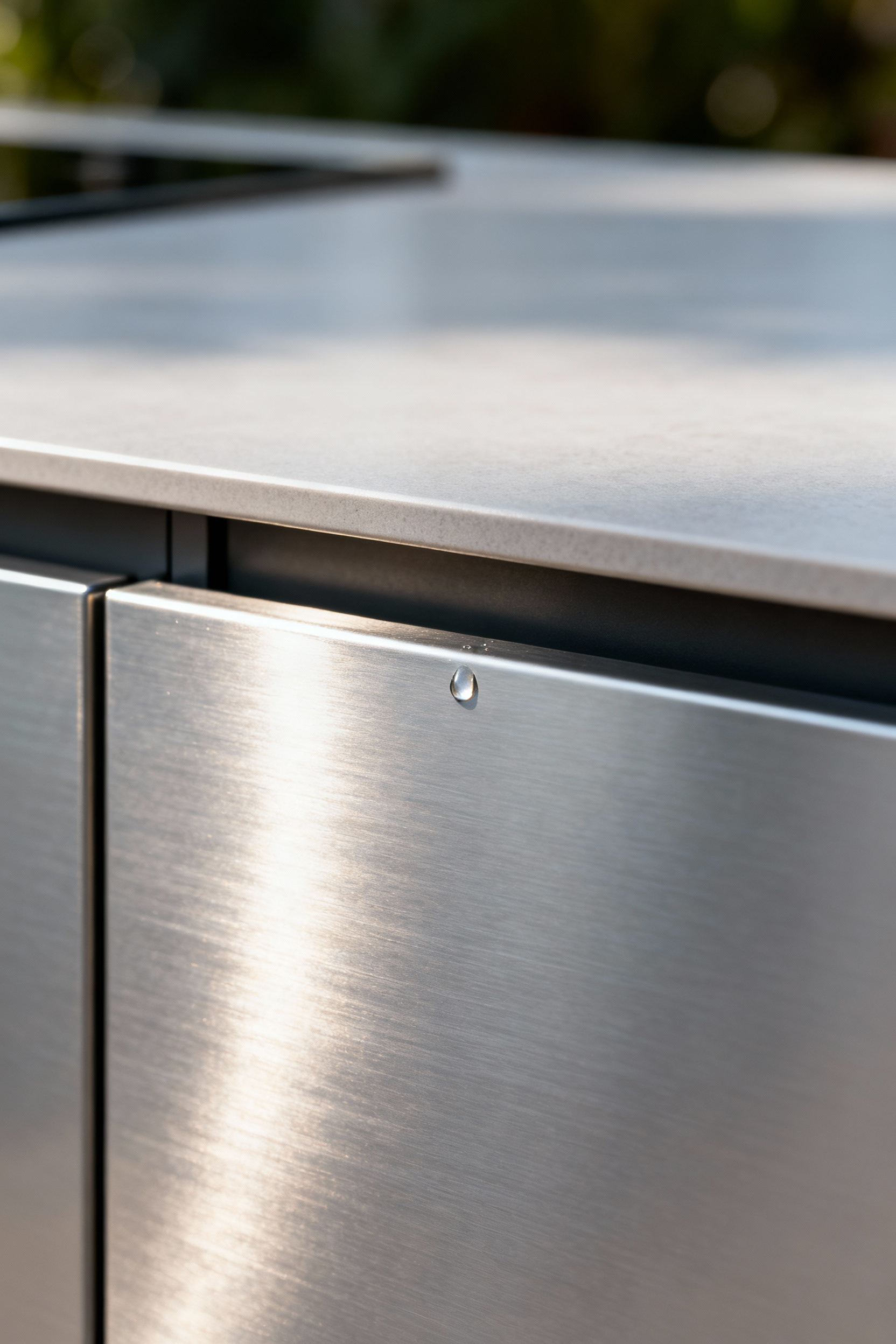
A professional plan routes these utilities through dedicated, sealed chases within or directly behind the outdoor kitchen cabinets, all while adhering strictly to local building codes. This protects the infrastructure from moisture and physical damage, and it ensures that service access is possible without having to rip everything apart. Let’s be honest: this isn’t the place to cut corners. Investing in a clean, code-compliant utility plan is a direct investment in the safety and long-term viability of your entire outdoor living space.
11. Leverage Modular Cabinet Designs for Scalability and Future-Proofing Your Outdoor Space
Life changes. Your family grows, your entertaining style evolves, and new appliance technology emerges. Building a massive, custom, one-piece outdoor kitchen can feel limiting down the road. This is why I often advocate for a modular approach. It’s a wonderfully intelligent way to future-proof your investment.
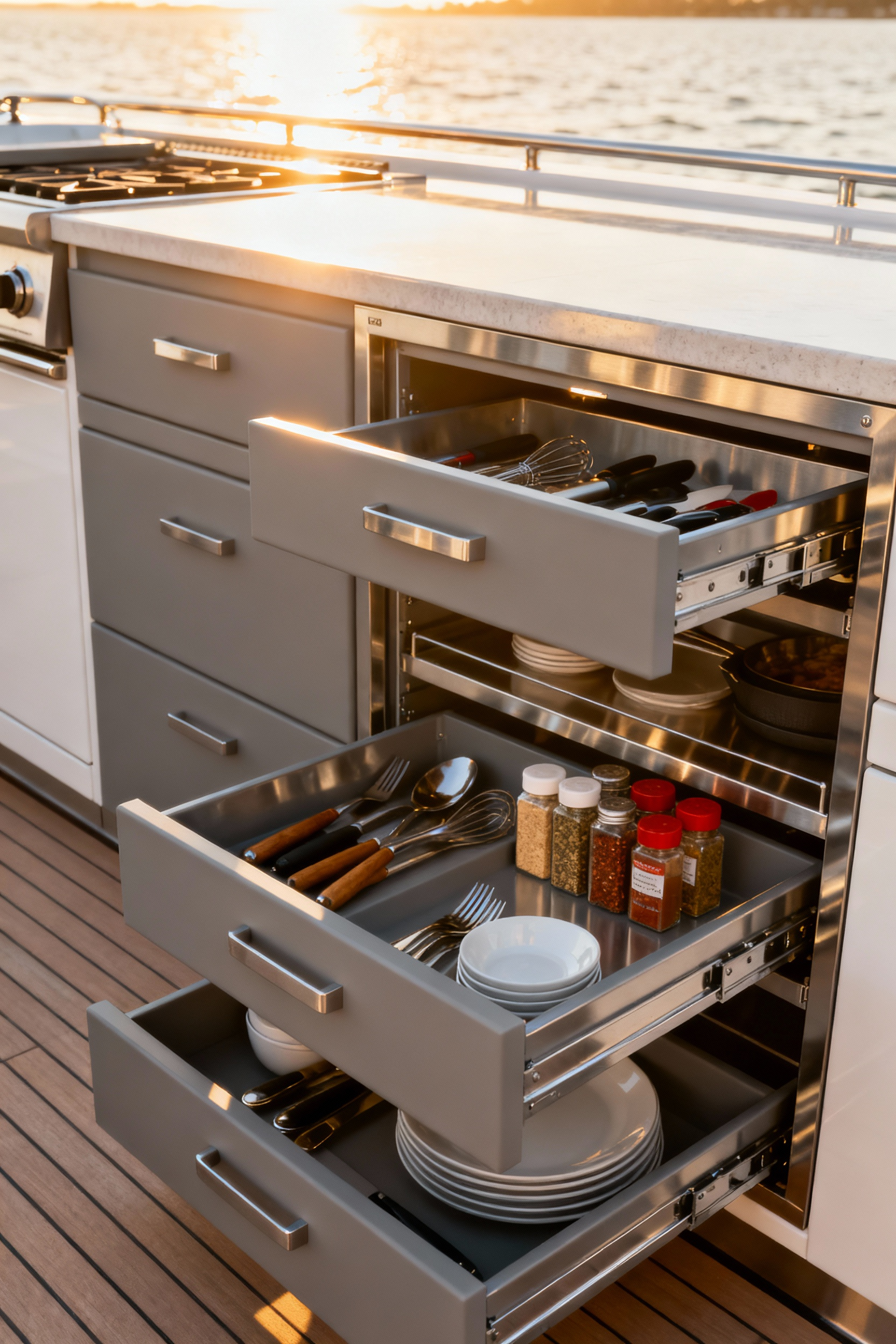
Modular outdoor kitchen cabinets allow you to start with the essentials—a grill base and some prep space, perhaps—and then expand your kitchen over time. Want to add a sink and refrigerator in a few years? Or a dedicated pizza oven station? With a modular system, you can add new pieces that seamlessly integrate with your existing setup. In my professional experience, this flexibility provides tremendous long-term value, allowing your outdoor space to grow and adapt right alongside your life.
Professional-Level Outdoor Kitchen Cabinet Strategies (Part 1)
Here, we shift from building a component to creating an environment. This is where deep expertise comes into play—orchestrating a perfect union between the built kitchen, the surrounding landscape, and your home’s architecture. It’s about creating a space that feels completely intentional and timeless.
12. Orchestrate Seamless Whole-System Integration with Surrounding Hardscapes and Landscaping
The most breathtaking outdoor kitchens don’t feel like they were just dropped onto a patio. They feel like they grew there. This is where my work as a landscape architect becomes critical. It’s about creating a conversation between the hard materials of your kitchen and the soft, living elements of your garden, so the entire space feels like a single, cohesive design.

This starts by choosing outdoor kitchen cabinet materials and colors that complement your existing stone, pavers, or decking. A cabinet with a dark, textured finish can beautifully echo a natural bluestone patio. But it goes deeper. We use plantings to soften the hard lines of the cabinetry, frame the kitchen to make it feel like its own “room,” and ensure sightlines from the house look out onto a beautiful, integrated scene. It’s about designing an entire system, not just a cooking station.
13. Commission Bespoke Cabinetry and Customization for Unique Architectural Cohesion
While modular systems offer great flexibility, sometimes a space calls for a truly custom solution to achieve a flawless look. Bespoke cabinetry allows you to create an outdoor kitchen that perfectly fits the unique quirks and architectural character of your home. It’s the difference between a nice kitchen and an undeniable extension of your house.
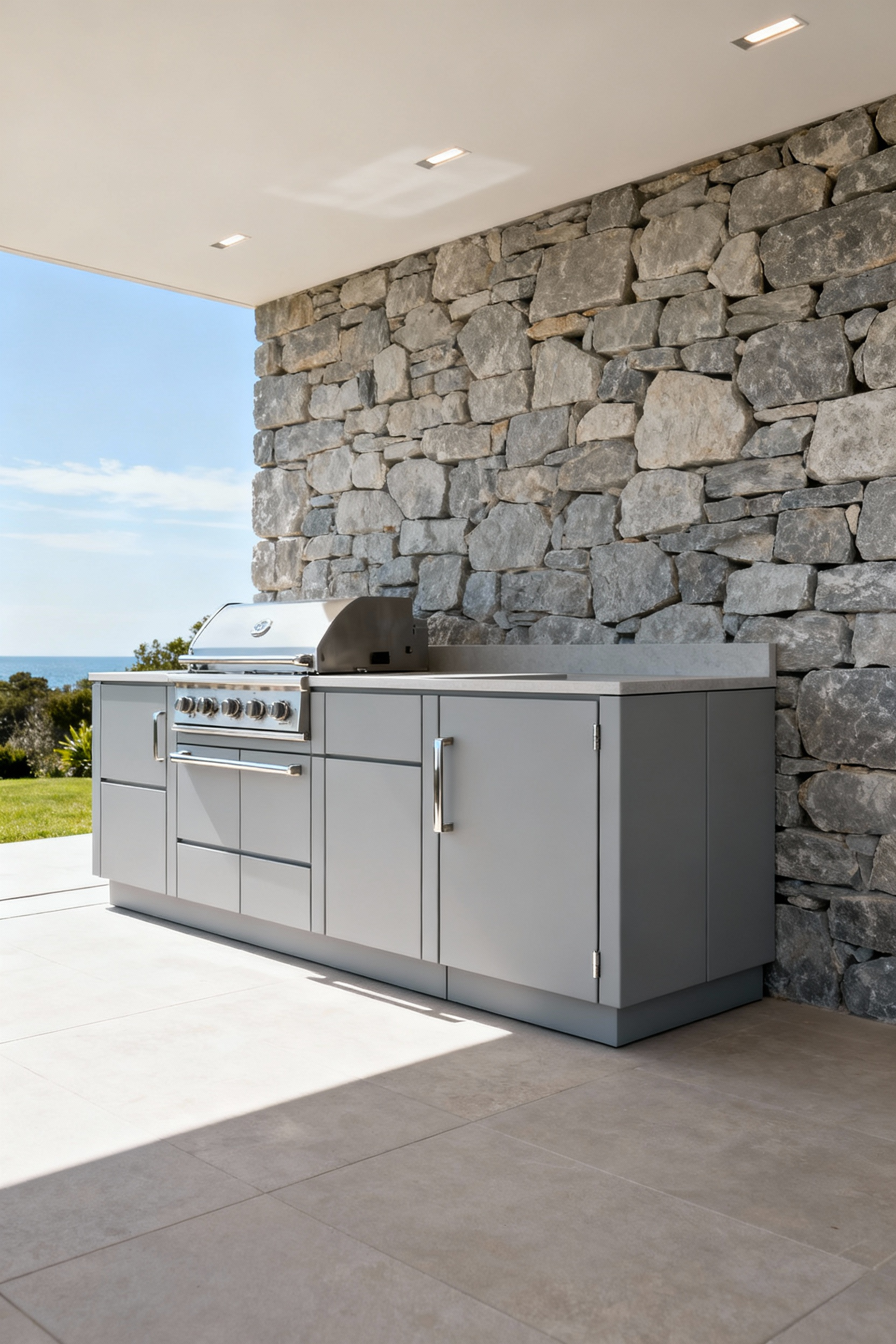
Customization means you can design cabinets that fit into an unusual corner, wrap around a structural column, or align perfectly with a window sill. Aesthetically, it lets you echo design details from your home—like a specific door style or a particular type of hardware—in your outdoor kitchen cabinets. This level of detail creates a powerful sense of architectural cohesion, making the outdoor space feel like it was always meant to be there.
14. Implement Proactive, Lifecycle-Based Maintenance Protocols for Enduring Aesthetic and Performance
Even the most durable materials benefit from a little care. Investing in high-performance outdoor kitchen cabinets is the first step; establishing a simple, proactive maintenance plan is what ensures they look and perform their best for decades. This doesn’t have to be a chore; it’s about smart, responsible ownership.
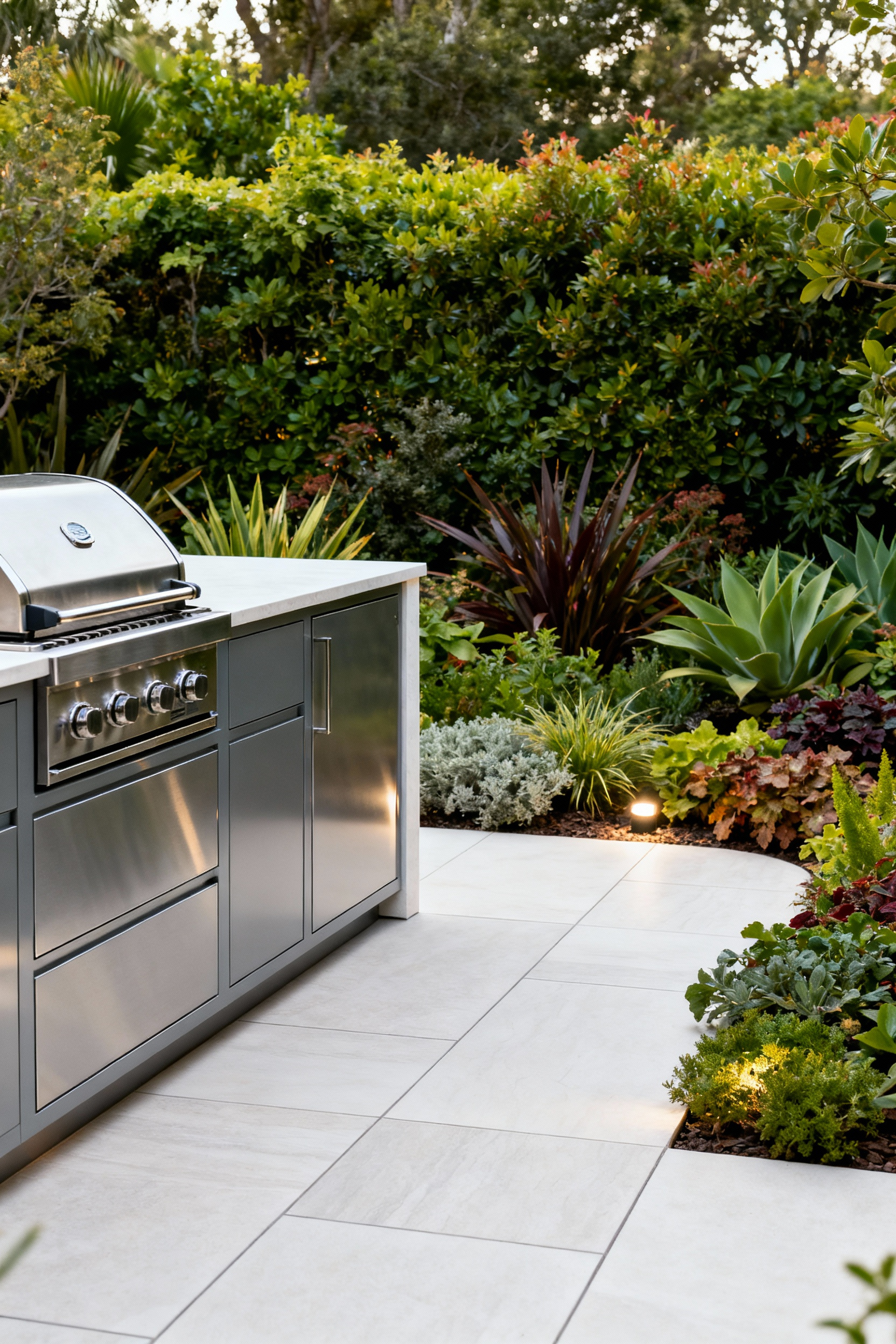
A good lifecycle-based plan is tailored to your specific materials and climate. For stainless steel, it might mean a periodic cleaning to maintain its protective layer. For polymer, it might be an annual application of a UV protectant. What I tell my clients is to create a simple seasonal checklist: check and lubricate all hardware in the spring, ensure proper drainage before winter, and give everything a thorough cleaning after pollen season. This little bit of attention prevents small issues from becoming big problems and protects your valuable investment.
15. Evaluate Material Environmental Impact and Prioritize Ethically Sourced, Sustainable Options
Creating a space that connects you with nature should also involve honoring it. The choices we make for our outdoor kitchens have an environmental footprint, and I believe in prioritizing options that are both beautiful and responsible. A truly enduring design considers its impact on the world around it.

This starts with durability itself—a cabinet that lasts 20 years consumes fewer resources than one that needs replacing every five. But we can go further. Look for outdoor kitchen cabinets made from recycled materials, like many high-grade polymers. For any wood components, insist on certifications like those from the Forest Stewardship Council (FSC) that guarantee responsible forestry. Choosing low-VOC (volatile organic compound) finishes is better for air quality. This approach ensures your outdoor sanctuary is built not just in nature, but in harmony with it.
Professional-Level Outdoor Kitchen Cabinet Strategies (Part 2)
Finally, we arrive at the strategies that truly set a space apart. This is about looking to the future—integrating technology that enhances the outdoor experience, designing for timeless appeal, and recognizing when to bring in specialized expertise to guarantee a flawless result.
16. Leverage Integrated Smart Home Technology and Dimmable Lighting for Ambiance and Functionality
Lighting can make or break an outdoor space. A single, harsh floodlight over the grill is purely functional, but it does nothing for ambiance. The goal is to create layers of light that can adapt to any situation, from intense task lighting for cooking to a soft, warm glow for late-night conversations.

Integrating this lighting into a smart home system takes it to the next level. Imagine presets you can control from your phone: a “Prep Mode” with bright, clear light over the countertops, and a “Dine Mode” that dims the task lights and raises the ambient ones. From my outdoor kitchen design projects, I can say that thoughtful, controllable lighting is one of the most impactful ways to extend the hours you can enjoy your outdoor space, transforming it from a daytime cooking area into a magical evening retreat.
17. Anticipate Future Trends in Outdoor Living to Achieve a Timeless and Adaptable Design
The way we live outdoors is constantly evolving. A truly great design anticipates this, creating a space that feels current today but won’t feel dated in a decade. This isn’t about chasing fads; it’s about investing in timeless quality and intelligent, flexible design.
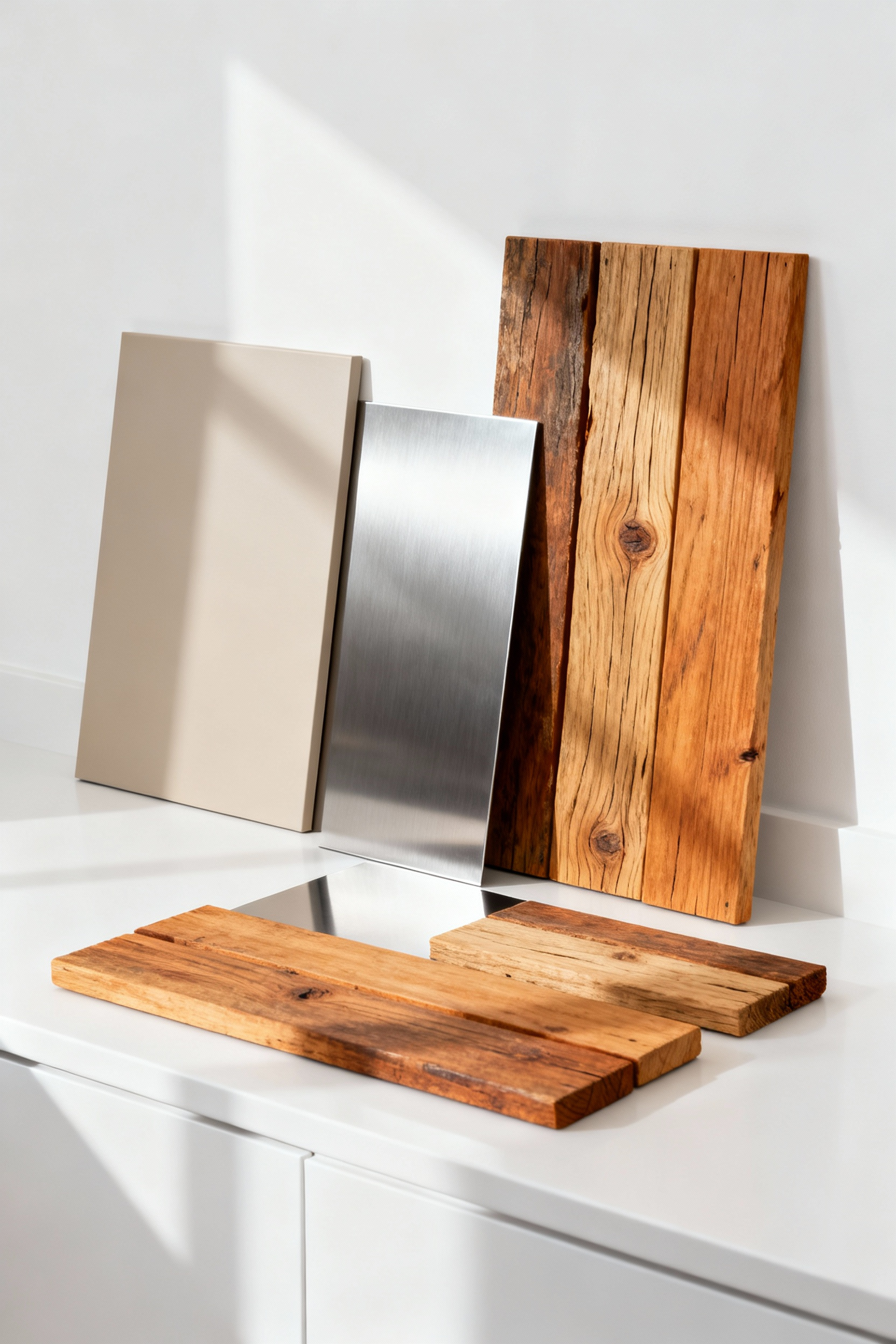
This means choosing classic materials and neutral color palettes for your permanent fixtures, like your outdoor kitchen cabinets. You can always update a space with trendy pillows or accessories, but the core should be built to last. It also means planning for future technology. We do this by including easily accessible conduit for future wiring or designing cabinet layouts that could accommodate a new appliance down the road. It’s about creating a beautiful, resilient foundation that is ready for whatever comes next.
18. Engage Expert Outdoor Living Design Consultants for Flawless Conception and Execution
You can do all the research in the world, but there’s no substitute for experience. Pulling all these elements together—material science, site planning, structural needs, aesthetics, and utility integration—is a complex art. An expert outdoor living designer or landscape architect is trained to see the entire picture.

A professional consultant helps you avoid costly mistakes, navigates complex building codes, and brings a level of creativity and problem-solving that comes only from years of dedicated practice. They are your advocate, ensuring that the final execution matches the initial vision. Investing in professional expertise isn’t a luxury; it’s the surest way to protect your investment and ensure your outdoor kitchen is a source of joy, not headaches, for years to come.
Conclusion
After walking through these strategies, I hope one thing is clear: creating an exceptional outdoor kitchen is a thoughtful process, not just a purchase. The mainstream idea that you can simply pick a “weatherproof” cabinet and expect it to last is, frankly, a disservice. We’ve moved beyond that superficial understanding to see that real endurance is born from a deep respect for your climate, intelligent material choices, and a design that integrates seamlessly with your home and your life.
As an outdoor living designer, my guiding principle has always been to work with nature. The most successful projects are not those that fight the elements, but those that anticipate and accommodate them with smart, resilient design. These 20 strategies are your toolkit for doing just that. They’re about empowering you to ask the right questions and demand a higher standard, ensuring your outdoor kitchen becomes a lasting, integral part of your home—a place for connection, nourishment, and quiet moments in the fresh air.
So as you move forward, I encourage you to use this knowledge. Challenge the simple answers. Insist on quality that goes beyond the surface. By applying these principles, you’ll be able to create an outdoor space that doesn’t just function, but thrives. You’ll be building more than a kitchen; you’ll be crafting an enduring legacy of a life well-lived, outdoors.
